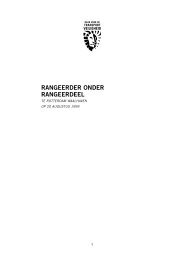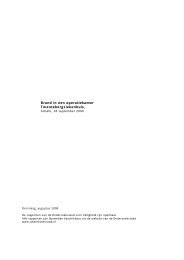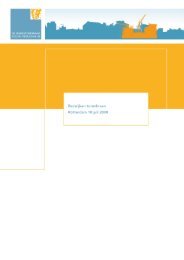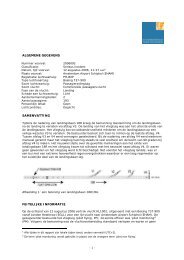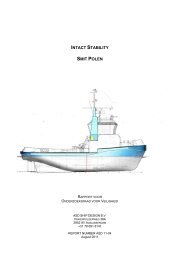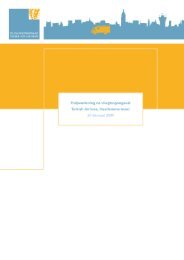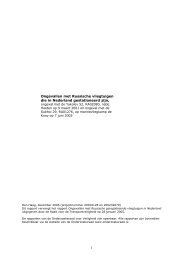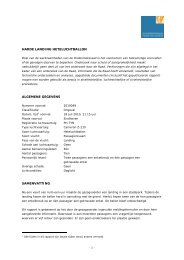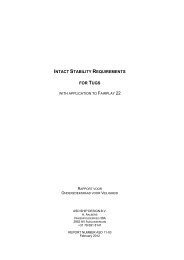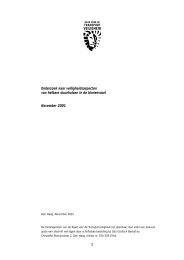Rejected takeoff after the takeoff decision speed 'V ', Boeing B737 ...
Rejected takeoff after the takeoff decision speed 'V ', Boeing B737 ...
Rejected takeoff after the takeoff decision speed 'V ', Boeing B737 ...
You also want an ePaper? Increase the reach of your titles
YUMPU automatically turns print PDFs into web optimized ePapers that Google loves.
APPENDIX A: JUSTIFICATION OF INVESTIGATION<br />
Scope<br />
The investigation of <strong>the</strong> Dutch Safety Board focuses on determining <strong>the</strong> causes or probable causes,<br />
<strong>the</strong> underlying conditions and possible structural safety shortcomings that form <strong>the</strong> basis which<br />
caused <strong>the</strong> event.<br />
The following aspects were not investigated fur<strong>the</strong>r, nor partly investigated:<br />
• Specific individual flight crew training and performance<br />
• Aircraft systems and components removed from <strong>the</strong> aircraft<br />
• Emergency response of <strong>the</strong> airport<br />
Interviews<br />
Interviews were held with <strong>the</strong> two flight crew members. A statement was received from <strong>the</strong> avionics<br />
engineer who performed test and maintenance on <strong>the</strong> aircraft <strong>after</strong> <strong>the</strong> event. General information<br />
on <strong>the</strong> operation and flight crew training was received from Rayanair.<br />
Draft report<br />
A draft report was submitted to <strong>the</strong> parties directly involved in accordance with <strong>the</strong> Dutch Safety<br />
Board Act in order to review <strong>the</strong> report on factual inaccuracies. The draft version of this report has<br />
been submitted to <strong>the</strong> following parties:<br />
• The captain<br />
• The copilot<br />
• Air Accident Investigation Unit, Ireland<br />
• Operator Ryanair, Ireland<br />
• National Transportation Safety Board, United States of America<br />
• <strong>Boeing</strong> Commercial Airplanes, United States of America<br />
• European Aviation Safety Agency<br />
To <strong>the</strong> extent of non-textual, technical aspects and factual inaccuracies are concerned, <strong>the</strong> Safety<br />
Board has incorporated <strong>the</strong> comments received into <strong>the</strong> final report. The received comments to<br />
which <strong>the</strong> Board has not amended <strong>the</strong> report <strong>the</strong> Board has formulated a response given here.<br />
Comments not incorporated: paragraph 2.4<br />
AAIU comment: I would respectfully suggest that a new paragraph be inserted here which<br />
concerns an operational aspect to <strong>the</strong> event. At <strong>the</strong> beginning of <strong>the</strong> <strong>takeoff</strong> run, <strong>the</strong> aircraft was<br />
completely serviceable with no indications of any defects. Yet by <strong>the</strong> V 1<br />
call, <strong>the</strong> First Officer was of<br />
<strong>the</strong> opinion that <strong>the</strong> aircraft was ‘unsafe to fly’. Apart from <strong>the</strong> standard ’80 kts‘ call, <strong>the</strong>re was no<br />
communication between ei<strong>the</strong>r Flight Crew that anything was amiss or perceived to be amiss during<br />
<strong>the</strong> entire <strong>takeoff</strong> run. While an operational issue, <strong>the</strong> lack of effective crew co-ordination during<br />
<strong>the</strong> take-off run may need to be discussed. Had <strong>the</strong> First Officer communicated his misgivings<br />
regarding <strong>the</strong> directional control earlier <strong>the</strong>n <strong>the</strong> problem ‘perceived’ by him may have been<br />
resolved or <strong>the</strong> <strong>decision</strong> made to stop by <strong>the</strong> Commander at a safe <strong>speed</strong> well below V 1<br />
Board response:<br />
The goal of <strong>the</strong> investigation was to answer <strong>the</strong> investigative questions ase desribed in chapte 1<br />
paragraph 1.2.2 with <strong>the</strong> facts that are available. The <strong>takeoff</strong> roll was described using <strong>the</strong> available<br />
information from <strong>the</strong> flight data recorder and <strong>the</strong> statements made by <strong>the</strong> crew during interviews.<br />
Because <strong>the</strong> Cockpit Voice Recorder was not available <strong>the</strong>re was no factual evidence available<br />
that would allow <strong>the</strong> assessment of <strong>the</strong> cockpit crew co-ordination. To asses <strong>the</strong> cockpit crew<br />
co-ordination based on statements alone is insufficient.<br />
Comments not incorporated: paragraph 2.9 …. Position of <strong>the</strong> AOA sensor…..<br />
Remark - Air Accident Investigation Unit – “AOA comment is not relevant and should be removed.<br />
AOA movement with <strong>the</strong> aircraft stopped is entirely normal and not relevant to this incident.”<br />
27




